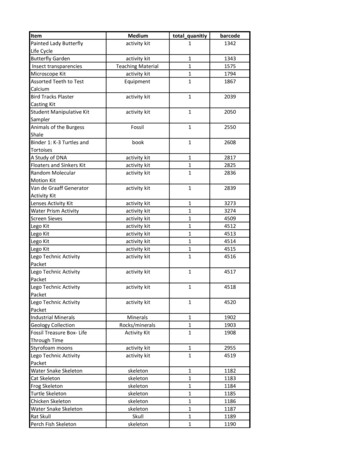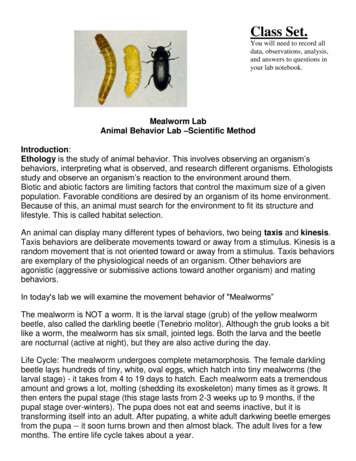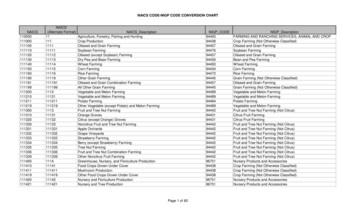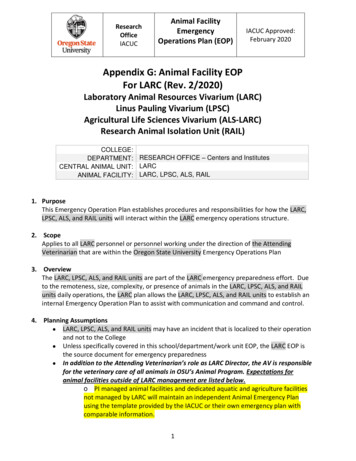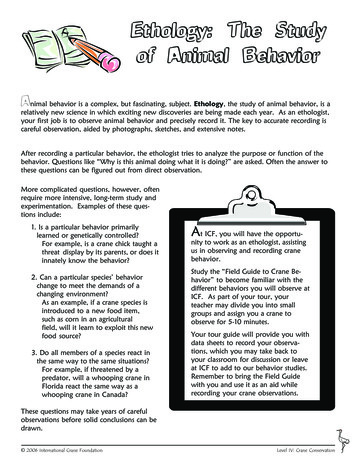
Transcription
Ethology: The Studyof Animal BehaviorAnimal behavior is a complex, but fascinating, subject. Ethology, the study of animal behavior, is arelatively new science in which exciting new discoveries are being made each year. As an ethologist,your first job is to observe animal behavior and precisely record it. The key to accurate recording iscareful observation, aided by photographs, sketches, and extensive notes.After recording a particular behavior, the ethologist tries to analyze the purpose or function of thebehavior. Questions like “Why is this animal doing what it is doing?” are asked. Often the answer tothese questions can be figured out from direct observation.More complicated questions, however, oftenrequire more intensive, long-term study andexperimentation. Examples of these questions include:1. Is a particular behavior primarilylearned or genetically controlled?For example, is a crane chick taught athreat display by its parents, or does itinnately know the behavior?2. Can a particular species’ behaviorchange to meet the demands of achanging environment?As an example, if a crane species isintroduced to a new food item,such as corn in an agriculturalfield, will it learn to exploit this newfood source?3. Do all members of a species react inthe same way to the same situations?For example, if threatened by apredator, will a whooping crane inFlorida react the same way as awhooping crane in Canada?At ICF, you will have the opportunity to work as an ethologist, assistingus in observing and recording cranebehavior.Study the “Field Guide to Crane Behavior” to become familiar with thedifferent behaviors you will observe atICF. As part of your tour, yourteacher may divide you into smallgroups and assign you a crane toobserve for 5-10 minutes.Your tour guide will provide you withdata sheets to record your observations, which you may take back toyour classroom for discussion or leaveat ICF to add to our behavior studies.Remember to bring the Field Guidewith you and use it as an aid whilerecording your crane observations.These questions may take years of carefulobservations before solid conclusions can bedrawn. 2006 International Crane FoundationLevel IV: Crane Conservation
AN INTRODUCTIONTOCRANESCranes are one of the most vulnerable families of birds in the world, with ten of the fifteen species considered threatened or endangered. The two species of cranes in North America demonstrate the range ofpopulation sizes: over half a million sandhill cranes live here, while fewer than 300 whooping cranes survivein the wild. Sandhill cranes are considered to be one of the oldest known living species of bird, with fossilevidence showing sandhill cranes in North America almost ten million years ago. Of the seven continents,only South America and Antarctica lack cranes.Herons, storks, and spoonbills also have long legs, necks, and bills and look similar to cranes, but arenot closely related. Rather, the different families have evolved similar adaptations to a common wetlandhabitat. In actuality, the smaller coots, rails and limpkins are the closest relatives to cranes.Individual and Social BehaviorCranes pursue each other, or small prey, by running. A running crane takes one to three stepsper second and may extend its wings for more speed or balance. While ungainly looking, cranescan outrun a human. All cranes can swim, but adults usually avoid it unless necessary. Chicks areactive a few hours after hatching, and must swim if they are to follow their parents, since mostcranes nest in wetlands.Feathers give cranes both the ability to fly and to regulate their temperature. Made of thesame material as human fingernails and hair, feathers require constant attention. A crane preens by nibblingthe base of a feather and then drawing it through the bill. This is particularly true for the large flight feathers.Feathers are replaced during a seasonal molt, when old feathers are pushed out by emerging new feathers.Most species of crane are flightless during this period, and usually molt during chick-rearing. It is not unusualfor flightless cranes to stay near heavy cover until they and their young can fly.When preening, cranes smear their feathers with oil from an oil gland located on the upper side of thetail. Contrary to previous belief, the oil does not serve as waterproofing, but helps condition the feathers andmay have fungicidal and antibacterial properties. Prolonged preening follows water or dust bathing.Some sandhill cranes also “paint” themselves by preening mud into their feathers prior to the breedingseason. Painting is an important camouflage tactic that helps sandhill cranes hide amid the brown vegetation in a springtime marsh. Siberian cranes also paint themselves near the base of the neck as part of abreeding ritual.ocalizationsDisplays and VVocalizationsCranes are aggressive birds. When fighting, they leap into the air to rake opponents withtheir sharp claws. This continues until one bird runs or flies away. But fighting is dangerous, socranes have developed a complex system of warning behaviors to prevent combat.Communication with other cranes includes physical postures and vocalizations. Crouchthreats, ruffle threats, drop-wing threats, and flight intention postures are some of the behaviorsyou may see during your visit to ICF. Most crane species use a red patch of skin on the head asa warning display. Cranes can pump extra blood to the patch, turning it a bright crimson, andthen point the patch at an invader or opponent.The contact call is a soft, purring call made by adult cranes. This call alerts other cranes to the caller’swhereabouts. The young have a high-pitched, peeping contact call. Chick distress calls are louder than theircontact call, and parents react quickly to them. Beyond an age of about three months, chicks are able toperform the guard call, a single loud call that warns other cranes of danger. 2006 International Crane FoundationLevel IV: Crane Conservation
The most significant vocalization is the “unison call.” A pair gives the unison call together either to formand strengthen pair bonds or to enforce territory boundaries. In many species, the female has a two-note callwhile the male has a single-note call. Males of some species, such as the white-naped crane, Siberian crane,and brolga, may flex their wings while unison calling. Members of a pair usually stand within a few feet ofeach other while unison calling.A unique call made by the grey crowned cranes is “booming.” The birds use their gular sacs to developresonance. The gular sacs are the small red pouches hanging below their chins. Crowned cranes also use a“quack” call to locate their mates.Flight and MigrationCranes typically run into the wind to achieve the speed necessary for flight. Cranesmay fly as fast as fifty two m.p.h. without a helping wind during level, flapping flight.When soaring in thermals (updrafts of warm air), cranes will circle until they reach a desiredaltitude, usually between 3,000 and 5,000 feet. They then leave the thermal and glide forwardwhile losing altitude. Next, they find another thermal and repeat the procedure. Some species,though, fly much higher to clear mountain ranges.Flapping flight is an energy-intensive activity. Although soaring in thermals is slower than level flapping flight, it conserves energy. Cranes usually spend two days feeding for every day they fly during migration. Daily flights may range from a few miles in bad weather to several hundred miles if suitable stopoverpoints are unavailable. Cranes also fly further on days when there are favorable winds. Cranes begin theirmigration in families or small groups. As migration progresses, however, groups join to form flocks of up toseveral thousand birds.At night, migrating cranes roost at “staging areas” in water that is deep enough to cover their toes.Staging areas consist of safe roosting sites in shallow marshes or on submerged sandbars in rivers. There areusually good foraging areas within a short flight of the roosting sites. Examples of staging areas used bysandhill cranes include the Platte River (Nebraska), Jasper-Pulaski State Wildlife Area (Indiana), and theSandhill Wildlife Demonstration Area (Wisconsin).Nesting and ReproductionCranes have low reproductive capabilities. A pair will produce only one or twochicks each year, but that production will continue through most of their twenty tothirty year life-span. Their survival strategy is the opposite of short-lived animals, likerabbits or mice, with high reproductive rates. Cranes typically do not begin breeding untilthree to four years of age, and some species, like the Siberian crane, may not nest until they are five to sevenyears old.Cranes are territorial during the breeding season, with each pair defending an area in which it willattempt to raise young. Sandhill cranes may nest in areas of less than five acres, but the average territorysize is larger than fifty acres. Larger crane species typically have larger territories. Territories will tend to besmaller in areas of abundant food, good nesting habitat, higher population densities, and little disturbancefrom predators or humans.It takes a crane pair from one to seven days to build a nest. Once the female lays the eggs, the pairshares incubation duties. The "nest exchange," or switching of incubation duties, occurs about every two hours,giving both birds a chance to feed and exercise.The time of hatching coincides with the emergence of insects that the young will feed on. This timing isparticularly important for migratory cranes so the young can grow and gain enough size and strength tomigrate before winter sets in. Timing of nesting is less important with non-migratory cranes.Most species of crane lay two eggs, but usually only one chick survives. The chicks are aggressive and oftenfight until one is driven away from the family group or dies from lack of attention. The remaining chick thenhas the complete attention of both parents and has a very good chance of surviving, even when food isscarce. 2006 International Crane FoundationLevel IV: Crane Conservation
Both parents feed the chicks, but the male usually feeds them first. The newly hatched chick may beoffered small pieces of the egg shell. The rest of the shell may be eaten by the female or carried away anddiscarded. Both parents brood, or sit over, the young birds to protect them from cold and precipitation.Brooding is important, since the chick cannot control its body temperature for the first few days after hatching.The family may leave the nest a day after the second chick hatches, but return to the nest in the evening forseveral days. The young birds may beg for food by “bill-touching” with their parents.Cranes as “Flagship“Flagship”” SpeciesBiological communities are a complex web of life, incorporating all the organisms that exist in an area.In many of these communities, cranes occupy one of the upper levels of the food pyramid. Since they aredependent upon so many other species below them, biologists consider cranes to be flagship species; thehealth of the crane population is often a good indicator of the health of the ecosystem as a whole. By working to protect cranes, we work to protect all the other community members which may not be as conspicuousor easily recognized.WetlandsMost of the world’s crane species rely on wetlands for their survival. Within thesecomplex ecosystems, cranes find the necessary resources to survive.Feeding is one of a crane’s most time consuming activities. In wetlands, food isabundant in many forms: seeds, small mammals and reptiles, eggs of other birds, insectsand other invertebrates, such as worms, clams, and crayfish. In addition, cranes findvaluable carbohydrates in the starchy tubers growing on the roots of many wetland plants.Cranes are well-adapted to such food sources, with long beaks and necks which allowthem to probe deep into the water and muck of a wetland.The tall vegetation of a shallow marsh also helps hide cranes from predators, especially while nesting.In deeper marshes, cranes build massive nests sometimes five to six feet across and high enough that thewater doesn’t touch the eggs. Often a “moat” forms around the nest because the cranes use so many of thenearby plants for constructing the nest. The standing water protects the birds, as the noise of splashing willalert the parents of an approaching threat.Many other creatures also make their homes in the wetland community. It is estimated that over onethird of all threatened or endangered species in the U.S. are found in wetlands. Mammals such as beavers,muskrats, rabbits, and deer depend on the food and shelter of wetlands, as do waterfowl and other migratorybirds.Humans, too, reap many benefits from wetlands. Wetlands are known to reduce or prevent floodingand remove pollutants and sediment from surface water. As a source of food for humans, wetlands providespawning grounds for about 90% of the fish and shellfish harvested in the coastal U.S.Despite these benefits, wetlands continue to decline throughout the world. Often considered only asuseless waste areas, wetlands have been drained, filled, plowed, and developed. Their seasonal nature canmake them difficult to identify, and many are destroyed during dry periods when it appears they are nolonger functional. Yet in most cases, dry spells of a few months to a few years are natural, and do not reducethe value of the wetland.Wisconsin retains only about 54% of its original wetlands. Since the 1800s, almost half of the wetlandsin the contiguous U.S. have been destroyed, and approximately 300,000 additional acres are lost everyyear. Not only does this trend threaten the plants and animals which live in wetlands, but it also threatenshuman communities which rely on wetland processes. 2006 International Crane FoundationLevel IV: Crane Conservation
PrairiesIn addition to their reliance on wetlands, most cranes will also use upland areas forfeeding. Demoiselle and blue cranes nest in upland areas, and show physical adaptations,such as their shorter bills, for feeding on insects and seed pods that they find there.Prairies were common throughout the Midwest before Europeans settled here in the1800s. Prairie communities host hundreds of species of grasses and flowers, which supportmany mammals, insects, and birds, including cranes.Specifically adapted to survive the Midwest’s extremes of temperature and moisture, prairie plants investtwo-thirds of their growth underground. Roots may reach up to eighteen feet down in the soil to insure thatthe plant will be able to find water during times of drought. This deep root system is one reason why prairiesoils were resistant to erosion before being cut by the plow. Ironically, the rich soils which prairies developedmade them very attractive as farmland and pasture. In Wisconsin today, only 0.1% of the original twomillion acres of prairie remains.Another factor in the decline of prairies has been the disappearance of the forces that sustain them.Fires periodically swept the landscape and removed woody vegetation. Large herbivores such as bison andelk also removed young trees by grazing and browsing. Both processes served to remove above-groundvegetation and return minerals to the soil where roots could gain access to them. Removal of fire, bison, andother large herbivores from Wisconsin allowed woody vegetation like sumac, cedar, and aspen to invade theprairies.Oak SavannaOne tree that is able to survive the effects of fire is the bur oak. This tree hasevolved a thick, corky bark, which insulates living tissue from the extreme heat ofa wildfire. The resulting mosaic of open grown trees widely scattered over alandscape of grasses and flowers, called savanna, was once the dominantecosystem in the lower half of the state, with over seven million acres present in1840.In this oak savanna setting, light conditions on the ground vary from opensun to complete shade. Both sun-loving prairie plants and shade-tolerant forestspecies will thrive in very close proximity. The result is an incredibly rich diversityof plant and animal life. Unfortunately, savannas are also extremely rare.Today, only 1,360 acres remain in Wisconsin. 2006 International Crane FoundationLevel IV: Crane Conservation
Crane Life Cycle.The following life cycle applies to migratory crane species, such as the sandhill crane. Circle thecorrect choices to complete the life cycle diagram. For answers, refer to your handouts, “Field Guideto Crane Behavior" and "An Introduction to Cranes."1. Cranes pair: a) onlyduring the breedingseason; b) until their chickis mature; c) for life.2. In the spring, pairs establish:a) a staging area; b) a migration route;c) a territory in a wetland.3. The incubation period for acrane egg is a) 5 days; b) 30days; c) 60 days.ì10. The familymigrates totheir traditionalnesting area.Along the way,the one-yearold chick: a)joins a bachelor flock; b)establishes itsown territory;c) finds amate.4. Incubation of theeggs is done by: a) thefemale; b) the male;c) both parents.îFall9. All winter thecranes loaf and feedon: a) corn; b) snails;c) insects; d) plantroots; e) all of theabove.ë8. In the fall, the family migrates south withthe flock. The chicks know the migrationroute from: a) following their parents; b)instinct; c) by observing the stars. 2006 International Crane FoundationSummeréWINTERSPRINGêí5. Chicks developquickly and leavethe nest within aweek. At this time,they are able to findfood a) on theirown; b) from theirparents; c) with thehelp of other chicks.6. Shortly after thechicks hatch: a)chicks and parentsbecome aggressivetoward each other;b) the adults beginmolting feathers andcannot fly;c) bachelor flocksbegin invading nesting territories.7. At 3 months of age, thechick begins to a) leave itsparents; b) fly; c) breed.Level IV: Crane Conservation
Using the Old CraniumUse your “Field Guide to Crane Behavior” and “An Introduction toCranes” handouts to answer the following questions:1. Why do some sandhill cranes “paint” mud onto their feathers?2. Define the word “brooding.” Why is it important for a newly hatched chick to be brooded?3. What method of flight do cranes prefer to use for most of their migration? Why?4. In what situation would cranes use a distraction display? Why?5. What time of year are you most likely to hear a unison call? What is its function?6. Why are wetlands important for cranes?7. Name three behaviors that male and female cranes perform together.8. What forces are important in maintaining prairie and savanna ecosystems? 2006 International Crane FoundationLevel IV: Crane Conservation
You be the Guide!What do you know about cranes and endangered species conservation?After completing this activity, you will be well on your way to becoming a crane expert!Your teacher will assign each student or group of students a crane species and relatedtopic to research. After completing your research, each individual or group is responsiblefor presenting your results to the class. Don't panic! You may choose to do a formal oralpresentation, or be creative - design a poster, write a mock newspaper article, or evendevelop a play or short story to convey your findings to your class.Use the following questions to guide your research and presentation. Information on your related topicneed not be specific to the crane species that you are studying, but may focus on the conservation orbehavior issues associated with that topic.Crane Species:Related Topic:1. What is the current status of this crane species in the wild? Examine both population size and trendsand species distribution.2. What distinct physical characteristics or behaviors does this crane exhibit?3. What factors have contributed to the decline or growth of the wild population?4. Are there conflicts between the crane species and human populations?5. What is the connection between your crane species and the related topic?6. What other animal or plant species are affected by your related topic?7. What is the relevance of your related topic and the daily lives of your classmates? 2006 International Crane FoundationLevel IV: Crane Conservation
? ? ? Bewildering Behaviors ? ? ?1. a. Cranes use elaborate threat displays to avoid direct physical contact. Why do they usually use these threatdisplays instead of fighting over territorial boundaries?b. List four other animals that are territorial, and describe the “signal” or display they use to avoid conflict.Example: People ---- fences, signs1.2.3.4.2. Why do male and female cranes rotate the eggs when they change places on the nest during incubation?3. Most ground-nesting birds, like quail, ducks, geese, and cranes, have chicks that are precocial. This means thatupon hatching the chicks can see, have downy feathers, and strong legs so they can leave the nest. Why do youthink the crane chicks are adapted to leave the nest so quickly?4. Crane chicks also imprint very quickly. This means the chicks recognize the first large, moving object they seeas their parent. Why is it important that precocial birds imprint very quickly? What challenges does thispresent to captive breeding and reintroduction?5. Crane parents defend large wetland territories to protect their young and find food. But once the chickfledges (starts to fly) they become more mobile and are less territorial, even though the chick is still with them.Why?6. All crane chicks are either brown or gray for about 3-4 months. How does this coloration benefit the chicks?7. In many common species of birds (mallards, cardinals, etc.) males and females look strikingly different. Incranes, however, males and females look almost identical. What accounts for this difference between species? 2006 International Crane FoundationLevel IV: Crane Conservation
ETHOLOGICAL ELABORATIONS1. We have seen that cranes are territorial and use elaborate threat displays while defending their territory. Ethologists believe that displays have evolved from maintenance activities. Examples of maintenance activities include:eating, drinking, bathing, walking, and preening. Use your "Field Guide to Crane Behavior" to find those displaysthat look similar to, and may have evolved from, the maintenance activities listed below.incubating --- crouch display (EXAMPLE)walking --preening --wing flapping --feather ruffling ---Inner Wing FeathersCranes have evolved different structures andcoloration to make their displays more effective.Red-crowned cranes, for example, have long beenadmired for their beauty. But their beauty has afunction. Their striking coloration and body structures are used in territorial and breeding displays.The diagram to the right of a red-crowned craneshows the structures used in display behaviors.Red CrownNeck Stripe BeakLegs2. Using your Field Guide, find a display that uses each of the following structures, and describe how it is used.Legs (example): threat walk--slow walk with legs held up and stiff.Beak:Neck stripe:Inner wing feathers:Red crown:3. Why do cranes use their wings in many of the displays illustrated in your Field Guide?4. The red crown on the crane's head is used as a signal in territorial displays. Why? [Hint: to answer this questionthink about your reaction to the color red and it's use in our society] 2006 International Crane FoundationLevel IV: Crane Conservation
SIBERIANANDSARUS CRANES:ARUSSpecialists vsalistsvs. GenerGeneralistsSiberian cranes are rare, while Indian sarus cranes are comparatively more abundant. Ironically, theranges of the two species overlap during the winter (one of the three remaining Siberian crane populations winters in India). Why is one species rare and the other more common?1. While in India, Siberian cranes only feed on sedge tubers found in wetlands. Sarus cranes likewise eataquatic plants, but in addition commonly feed on grains, such as rice and wheat, and insects and rootsfound in vegetable fields. Examine the range of each species in India, and speculate on the effect feedinghabits might have on these differences. You will have to use both maps.2. Siberian cranes have been hunted throughout south and central Asia for centuries and are currently huntedfor meat and sport in Pakistan and Afghanistan. Sarus cranes have been strictly protected from hunting forcenturies in India, because the local people believe that killing one of these birds brings bad luck. Since acrane pair usually raises only one chick each year, how would hunting affect a population of cranes?Would the fact that Siberian cranes are hunted and that sarus cranes are not hunted tend to affect theirbehavior around people? For example, how would the two species react to human disturbance nearnesting or feeding areas? How might these potential differences affect their survival?3. The following are characteristics common to many endangered birds. Underline those relevant to Siberiancranes. Discuss, as a class, why each of these characteristics would contribute to endangered status. small range (especially islands) vs. large range hunting pressure vs. protection specialized habitat vs. general habitat specialized nest site vs. generalized nest site specialized feeding habits vs. generalizedfeeding habits slow reproduction vs. fast reproduction 2006 International Crane FoundationLevel IV: Crane Conservation
Siberian Crane MigrationThe endangered Siberian crane breeds in two distinct areas and migrates in three flocks to separatewintering areas. Use the figures provided to analyze the Siberian crane's migration routes.Use an atlas and the maps on the following page to answer questions 1-2:1. What countries does each flock pass through during their migration?2. Outline in dark pen or pencil hostile political borders that Siberian cranes cross during their migration. Howmight these tense borders affect ICF’s international conservation efforts?Use the figure to the right toanswer questions 3 and 4.3.How many different terrestrialecoregionsecoregions, or large areas withdistinct climates, ecologicalfeatures, and plant and animalcommunities, does the centralflock pass through during theirmigration? What geographicareas might they have to cross ina single flight (for example,mountains, deserts, etc.)? Wouldyou expect their feeding habits tochange during the spring breeding season, spring and fall migrations, and winter? If so, why?4. Cranes learn their migration route from their parents and are thought to navigate in part by geographic landmarks. Circle one landmark on the above map which Siberian cranes might use on each of the three migrationroutes.5. Migration is one of the most dangerous times for cranes. The central flock migrates about 3,500 miles oneway, while the western and eastern flocks each migrate about 3,100 miles one way. Drawing on youranswers to the previous questions, what are some of the threats that Siberian cranes may encounter duringtheir long and difficult migration? 2006 International Crane FoundationLevel IV: Crane Conservation
2006 International Crane FoundationLevel IV: Crane Conservation"Siberian Crane Migration" activity.Use these maps to answer the questions in theMaps courtesy of Milford Muskett.
Sandhill Cranes:Learned BehaviorThe crane behaviors observed at ICF are largely “programmed," orgenetically controlled, postures and calls. These displays are used primarily forcommunicating with other cranes in courtship, territorial defense, or flocking. We know that cranes do notlearn these displays, because a chick reared in complete isolation from other cranes will perform exactlythe same behaviors. Study the following list of behaviors observed in wild sandhill cranes, and answer thequestions below.Observations:A. Sandhill cranes are now nesting in wetlands that were traditionally thought to be too small to support cranes. Also,for the first time ever, pairs of sandhill cranes have been found nesting in marshes where they can see othernesting pairs. Formerly, crane pairs would not tolerate other cranes within view of their territory.B. Groups of sandhill cranes have recently been observed feeding in cow pastures, turning over piles of manure andfeeding on beetles.C. Families and flocks of sandhill cranes are now often seen feeding on waste grain in harvested cornfields.D. Flocks of unpaired birds, called “bachelor” flocks, will often walk through cornfields in the spring, picking youngcorn plants and eating the seed kernels.E. If landowners scare cranes away from their fields during the day, the cranes will feed at night.Questions:1. Some ethologists argue that sandhill cranes can learn, or acquire, behavior patterns. Use the information presented above to agree or disagree with this statement.2. How have the above behavior patterns helped sandhill cranes adapt to the current land-use patterns?3. Which of the above behaviors are “new,” and which are similar to things cranes might have been doing prior toEuropean settlers changing the landscape? 2006 International Crane FoundationLevel IV: Crane Conservation
SANDHILL CRANE TIMELINE.The following historical sequence outlines many of the key points in the history ofsandhill cranes in Wisconsin since European settlement:1840:butFirst settlement by Europeans in central Wisconsin begins. Sandhill crane population size unknown,possibly numbering 15,000.1890:Market hunters report shooting 80 cranes in one day near Portage. State crane populationestimated at 10,000.1915:State of Wisconsin Department of Agriculture reports that 80,000 acres of wetlands have beendrained in the last decade. Crane population estimated at 400.1926:State Conservation Commission makes hunting of cranes illegal.1929:Aldo Leopold estimates only 25 breeding pairs of sandhill cranes remain in state.1932:Economic depression deepens, many farms in former wetlands are abandoned.1935:Sandhill cranes declared an endangered species in Wisconsin.194
population sizes: over half a million sandhill cranes live here, while fewer than 300 whooping cranes survive in the wild. Sandhill cranes are considered to be one of the oldest known living species of bird, with fossil evidence showing sandhill cranes in North America almost ten million years ago. Of the seven continents,


